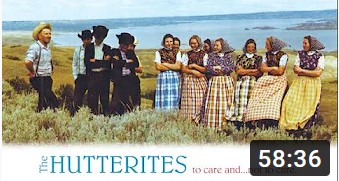
Children of Utopia - Documentary about the Hutterites (1999)
The great social Utopia of the last centuries produced several attempts of "utopic communes". The "Hutterischen Brüder", one of them, still exists in the south of Canada. In 400 kibbuzlike communities 40.000 members are living in the wide landscape of the country. In a remarkable social order, they economize succesfully and support themselves by own strength. Since 470 years they hold on to their medievel traditions and the huttererlanguage. Social injustice and war service is unknown in their community. The "Hutterischen Brüder" strictly refuse the modern media as an "devilish danger". But through friendship with some families, the director Klaus Stanjek took the chance to film the inner life of a Huttercommune. The "Children of Utopia" Thomas and Maria tell us about their everyday life in the commune. For the two "divine arks in the ocean of the worldly sin" their idea of the outer world stays shadowy.
A film by Klaus Stanjek © 1999, Ventana
Subscribe to wocomoHUMANITY: https://goo.gl/5Sp36B
Follow us on Facebook: https://www.facebook.com/wocomo/
Hutterites (German: Hutterer) are an ethnoreligious group that is a communal branch of Anabaptists who, like the Amish and Mennonites, trace their roots to the Radical Reformation of the 16th century. Since the death of their eponym Jakob Hutter in 1536, the beliefs of the Hutterites, especially living in a community of goods and absolute pacifism, have resulted in hundreds of years of diaspora in many countries. Nearly extinct by the 18th and 19th centuries, the Hutterites found a new home in North America. Over 130 years their population grew from 400 to around 45,000. Today, most Hutterites live in Western Canada and the upper Great Plains of the United States.

The Hutterites | To Care And Not To Care | Full Movie | John A. Hostetler | Arnold Hofer
The Hutterites | To Care And Not To Care | Full Movie | John A.
Hostetler | Arnold Hofer Spiritual cousins of the Mennonites and Amish, the Hutterites live simply with austerity. By a way of life that is supremely communal rather than individualistic, the Hutterites have rid themselves of poverty, homicide and anxiety about the future.
Hutterites (German: Hutterer), also called Hutterian Brethren (German: Hutterische Brüder), are an ethnoreligious group that is a communal branch of Anabaptists who, like the Amish and Mennonites, trace their roots to the Radical Reformation of the early 16th century.
The founder of the Hutterites, Jakob Hutter, "established the Hutterite colonies on the basis of the Schleitheim Confession, a classic Anabaptist statement of faith" of 1527, with the first communes being formed in 1528.[1][2][3] Since the death of their eponym Jakob Hutter in 1536, the beliefs of the Hutterites, especially living in a community of goods and nonresistance, have resulted in hundreds of years of diaspora in many countries.[2] They embarked on a series of migrations through central and eastern Europe. Nearly extinct by the 18th century, the Hutterites migrated to Russia in 1770 and about a hundred years later to North America. Over the course of 140 years, their population living in community of goods recovered from about 400 to around 45,000. Today, almost all Hutterites live in Western Canada and the upper Great Plains of the United States. Wikipedia
It is incredible that even 500 years after moving away from Germany in Europe Huttrites and Amish retain Upper German language.
Hutterite German is an Upper German dialect of the Bavarian variety of the German language, which is spoken by Hutterite communities in Canada and the United States. Hutterite is also called Tirolean, but this is an anachronism. Wikipedia
The Hutterites are community based similar to the Amish but believe in using modern technology except limits the usage of television and internet to avoid any bad influences. They work together and are very successful. Many non-Hutterite farmers are jealous on how successful they are.
The Hutterites are a successful example of religion, community, working together, using modern technology and unity to compete in the modern world.
All property and resources is owned by the colony, the resources are distributed to the families of the colony and equipment is shared between everyone much like a corporation.
15 year old are consider as adults have to start working more seriously while before the age of 15 it was more lack.
Unlike the birthrate of the other similar groups like the Amish the birthrate is not as high, this is probably due to marrying a bit later than the other groups and having their last child in their mid 30s but still much higher than average mainstream people.
Like the Amish and other similar groups they do not participate in the military and shun violence.
https://en.wikipedia.org/wiki/Hutterites
Hutterites looks to be a very liberal community as compared to say the Amish and many Mennonite groups. That is a shame because history has shown that communities that progress down that path tend to lose in the end. This goes even for major religious groups like the Catholic and Baptist churches which are losing members in substantial numbers if not for migrants. Hutterites still have positive birth rate, but for how much longer? Wealth, liberalism tends to break down families and communities and separate them for their beliefs and traditions.
There are 50,000 Hutterites and 500 colonies in North America.

Contents
Rules
'HUTTERITE COMMUNITIES': 'A way OF life' or 'A way TO life
Linked to article on - http://www.takeheed.info/pdf/January-...
Thank you for this faith confirming documentary. I should have been born a Hutterite or Huguenot. "community".
Hutterite History from 1525 to 1874. Hutterites were persecuted because they refused to baptize their babies and because they separated Church and State. Hutterites did not resist or retaliate. One adjustment to brute force was to die a willing death as followers of Christ. They were fully determined to make Jesus Christ the master of their lives. For His cause they were resolved to live and die.
Imagine if a film was made by Hutterites about the way we live. They could easily talk about all the people who get hooked on drugs, alcohol, sex and materialism. They would talk about how people have no security and many end up unhappy or even homeless. No lifestyle is perfect, it seems to me these folks life a life as legitimate and affirming as any. No life is paradise.
Contents
"Julie Clark explores life on a Hutterite colony not far from Saskatoon".
Stepping into the colony: A look at Hutterite life in Sask.
My Visit To A Hutterite Colony {+ How Hutterites are NOT like the Amish}

Julie Clark explores life on a Hutterite colony not far from Saskatoon.
I visited this colony in September 2011 and I stayed in the house of the Waldner family ? I'm living on a kibbutz near Jerusalem now. I loved my stay with the Hutterites of Forest River!
They built a new school building! And now they have 140 people! When I was there they had 103 people! I was so thrilled as I watched your video!
On our trip to Moravia we stopped at this place in Slovakia in Europe. It was the remains of an ancient Hutterite community. I was very impressed to see what was left here. They also had a very nice museum which told the early Anabaptists story. It was very impressive. edited.




Theophilus Jedediah